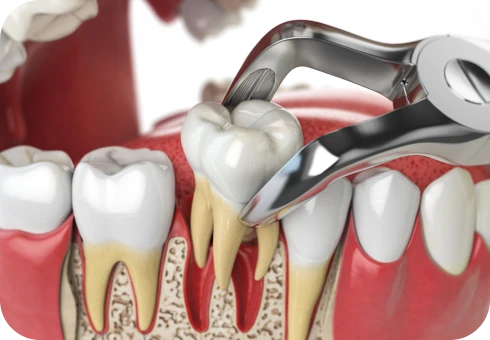Surgical dental avulsion
Tooth extraction involves removing a tooth directly from its socket in the jaw. Extraction of a single tooth can lead to problems with your ability to chew, joint complications and potential displacement of teeth, significantly affecting your oral health. To avoid these complications, Dr. Arnaud will discuss alternatives to extractions with you, if they exist, and explain the best options for replacing the removed tooth in your case.
The difficulty of extracting a tooth is determined by its position, type, initial condition and degree of impaction in the bone, and the procedure can be very rapid or require additional surgical time.
Why extract a tooth?
Tooth extraction is a very common procedure for many patients.
There are many reasons for removing a tooth, but the most common are :
- tooth decay that extends below the gum line and cannot be treated by a general dentist,
- an infection at the root tip that cannot be removed without removing the tooth,
- as a result of gum disease, called periodontal disease, which can destroy the bone around the tooth, making it loose,
- when jaws are too small, some teeth need to be removed symmetrically (left and right) during orthodontic treatment to align the teeth correctly and avoid crowding,

- remove an impacted tooth, which is often the case when wisdom teeth are extracted,
- extract a tooth or tooth remnants damaged by trauma, e.g. after a sports or car accident, or even a tooth fractured during a meal.
How is this procedure carried out?
The procedure for extracting a tooth is determined by how the tooth is damaged and where it is positioned in your mouth. Some tooth extractions are quick and easy, while others may require surgery.
The mandatory steps are as follows:
- A clinical examination and X-rays showing the entire tooth to be removed and the surrounding structures,
- A medical examination to find out about any pathologies or current treatments. You must inform your dentist of any medical problems you may have, and of any medication you are taking before the procedure.
- The procedure can be scheduled under local anaesthetic or general anaesthetic if the anxiety level or number of teeth to be removed is high.
To treat any infection, Dr. Arnaud may prescribe antibiotics before removing a tooth.
The stages of the intervention are as follows:
- Anaesthesia: The area concerned is first anaesthetized to ensure pain-free operation.
- Gingival incision: An incision is made at gum level to gain access to the tooth and underlying bone structures. This step is not always necessary.
- Tooth removal: The tooth is sometimes cut into several fragments to facilitate extraction. In some cases, a small portion of bone is also removed to free the tooth.
- Sutures: Once the tooth has been removed, the gum is sutured to promote rapid healing. Stitches are often absorbable, but in some cases may need to be removed a few days later.
What about post-operative care?
After surgical tooth avulsion, special care is required to ensure optimal healing and minimize the risk of complications. Dr. Arnaud will provide you with detailed instructions in a pre-operative consultation, but here are some general recommendations:
- Rest: It is advisable to rest and avoid strenuous physical activity for the first 24 to 48 hours after surgery.
- Pain management: Analgesic drugs may be prescribed to relieve post-operative pain. It is also recommended to apply ice packs to the affected area to reduce swelling.
- Oral hygiene: It’s essential to maintain good hygiene, and you can brush directly over the extraction area with a soft brush and your usual toothpaste. Antiseptic mouthwashes may be recommended.
- Food: Give preference to soft, lukewarm foods for the first few days to avoid any irritation of the operated area. It’s important not to use a straw, as aspiration could disrupt the formation of the blood clot essential for healing.
- Post-operative care: A follow-up visit is often scheduled to ensure that healing is proceeding smoothly.
What are the possible complications?
As with any surgical procedure, complications can arise, although they are rare. These include:
- Dry socket: This is a frequent complication after tooth extraction, when the blood clot protecting the socket dislodges too soon, causing intense pain.
- Infection: Although rare, infection can develop after extraction, particularly if oral hygiene is not rigorous or if an infection was present before the procedure.
- Numbness: In some cases, especially during complex extractions in the area of the lower wisdom teeth, temporary numbness of the tongue, lips or chin may occur due to proximity to the nerves.
Thanks to modern techniques and an approach focused on patient comfort, the procedure is carried out in optimal conditions to guarantee a rapid and effective recovery.
If you have any questions, or if surgical tooth avulsion has been recommended to you, please don’t hesitate to make an appointment for a consultation. Every situation is unique, and we’ll do our utmost to provide you with a personalized treatment tailored to your needs and circumstances.